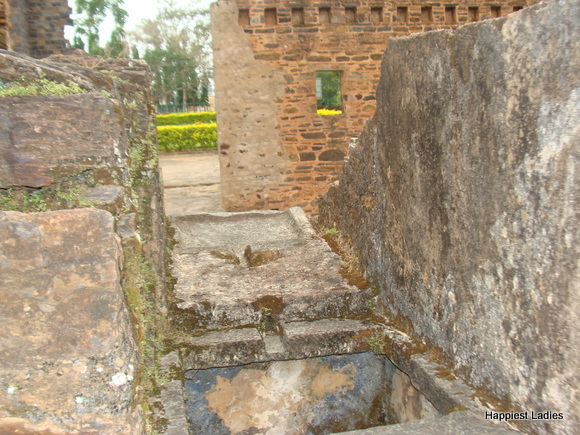Rani Chennamma’s Kittur – The Story of a Patriotic Queen
Read Previous Article: Oats Upma Recipe
Rani Chennamma hailed from Kittur, a small village now in the district of Belgaum. Kittur has a prominent regional history when it comes to fighting against the British rule.
The royal kitchen had its own unique style of exhaust system and water system. Stone containers and tanks were built to store water. The palace had a pipe system for water supply. The dining hall in the palace was a suitable for a huge affair; it could hold about 100 guests.
When you hear the name Rani
Chennamma, all that comes to picture is patriotism, valour, courage,
self-confidence, and the fight she put up against the mighty British forces.
 |
| Royal Emblem of Kittur Dynasty |
Rani Chennamma hailed from Kittur, a small village now in the district of Belgaum. Kittur has a prominent regional history when it comes to fighting against the British rule.
The Kittur Dynasty
Kittur became the seat power of
Kittur Kings during the 12th century. Hiremalla Shetty and
Chikkamalla Shetty were the rulers with whom the kingdom of Kittur started. As
a gift for their heroic deeds, the Shetty brothers received Kittur from Adil
Shahi, the king of Bijapur. The Shetty brothers ruled the region from Sampagaon
as their capital. The kidsom saw 11 more rulers after the founders.
The 6th ruler of the
kingdom, Mudimallapa Desai, moved the capital to Kittur and built the grand
fort and palace of royal residence at Kittur.
During the rule of the 11th
king, Mallasaraja between 1782 – 1816 Kittur experienced prosperity and welfare
eventually obtained great fame. This tempted Maratha Peshwa Bajirao II of Pune
to annex this small kingdom to his kingdom. In the pretext of extending a hand
of friendship, he invited Mallasaraja and treacherously imprisoned him. The
Kittur ruler died 3 years later in imprisonment.
Kittur Rani Chennamma; the Patriotic Queen
Mallasarja’s first wife Rudramma,
turned towards spiritualism while his second wife, Chennamma was an able
administrator.
Chennamma coronated Rudramma’s
son and the next king, but he proved to be a very weak ruler. Chennamma ruled
the kingdom on his behalf. Yet, the young king died issueless in 1824.
Seizing the opportunity of an
heirless kingdom, The British started interfering in the administration of
Kittur. British East India Company abolished the practice of adopting an heir
and annexed the kingdoms
to their provinces. Thackeray, the British collector of Dharwad,
seized the treasury of Kittur.
This provoked the Queen of Kittur
and confronted the collector defeating him and his men. Thackery was killed
by Amatur Sadhunavar Balappa who was a loyal body guard of Chennamma.
This victory was however short
lived. British in a few months attacked and seized the fort of Kittur. This
time Chennamma lost to the mighty British force. She was held in captivity at
the Bailhongal Jail.
Her aide Sangolli Rayanna continued
the struggle, but fell victim to the betrayal of his own people to the British
and was executed.
Chennamma, disheartened lost the
will to live and eventually breathed her last while still in British custody in
1829.
The patriotic queen who chose to
fight in spite of knowing that her army was no match to the large British army;
became a great inspiration to the subsequent freedom fighters of the nation.
Kittur Palace; Royal Residence of the Kings of Kittur
The royal residence of the kings
of Kittur now remains in ruins.
The British army destroyed the fort, looted the palace valuables, removed and sold the wooden doors and windows; literally left Kittur in a shattered state.
The British army destroyed the fort, looted the palace valuables, removed and sold the wooden doors and windows; literally left Kittur in a shattered state.
The grand palace popularly known
as Rani Chennamma's Palace was constructed in Peshwa-Islamic style.
The 3-storied palace was believed to have several rooms with durbar hall, rest rooms, discussion rooms, pole star viewing room, several kitchens, bath rooms, bath tubs, secret wells.
The 3-storied palace was believed to have several rooms with durbar hall, rest rooms, discussion rooms, pole star viewing room, several kitchens, bath rooms, bath tubs, secret wells.
 |
| Durbar Hall |
The royal kitchen had its own unique style of exhaust system and water system. Stone containers and tanks were built to store water. The palace had a pipe system for water supply. The dining hall in the palace was a suitable for a huge affair; it could hold about 100 guests.
 |
| Kitchen Room |
How to reach Kittur
Kittur can be reached easily by
road. There are many buses (private/government run buses) plying from many
other major cities.
Kittur is 50 km from Belgaum.
Belgaum is one of the prominent cities in Karnataka.
Good accommodations can be found
in Belgaum, Dharwad or Hubli.
Plan your trip to the historic
site of Kittur and experience the feel of patriotism and valour that is filled
in the air of Kittur.
If this space has been making you Happy so far, please like Happiest Ladies on Face Book. Also subscribe to the YouTube channel.





















Post a Comment